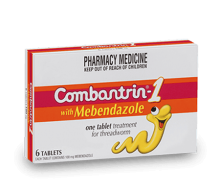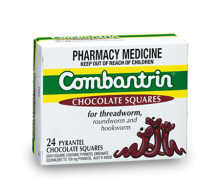Worms in adults and children is a common occurrence, and there are several types of worms that can cause problems - including threadworm, roundworm, whipworm, hookworm and tapeworm. Fortunately for those living in Australia and New Zealand, many of these worm types – namely roundworm, hookworm, whipworm and tapeworm - are considered rare. This is because they are more common in regions with a high population density and poor hygiene and sanitation facilities. As threadworm is the most common worm infection in Australia and New Zealand, this information focusses on preventing reinfestation of threadworm infections.
Taking steps to ensure that threadworms don't return after the initial infection is almost as important as the first treatment itself! Threadworms are highly contagious and can be spread through any of the sharing activities that are so important in childhood, from direct contact when playing sport to sharing toys with friends. Threadworm eggs can sometimes become airborne, making it even easier to spread and catch. Without proper action to prevent a reinfestation, you could end up facing recurring bouts of worms that are unpleasant for the whole family. Here's how you can help reduce your chances of a reinfestation and remain prepared in the face of threadworms.
Being prepared
Caregivers know the importance of being prepared, and that goes doubly in the case of worm infections! Having the right treatment on hand to react as soon as symptoms appear can really help get rid of the infection and ensure kids can go back to sharing some rough and tumble with their pals or siblings as soon as possible. Make sure you have COMBANTRIN® handy and be ready for any eventuality.
Treat the whole family
Treating just one member of the family for their threadworm infection and neglecting to treat the others increases the risk of reinfestation significantly. If you spot the signs and symptoms of a threadworm infection in one family member, be sure to act fast and treat everyone living in the house – including adults! Sometimes worm infections aren't flagged in other family members because not everyone will exhibit symptoms (especially adults) – so it's crucial to be on the safe side and treat everyone, rather than leaving a potential infection free to flourish.
Clean the home post-treatment
Once you've addressed the threadworm problem internally using COMBANTRIN® or COMBANTRIN®-1, you should also do a thorough clean-up of your home. Worm eggs can survive for several days on external surfaces, but you can play your part in preventing a reinfestation by doing the following:
- Wash all the bedsheets and linen that family members have been sleeping on with hot water, to kill any remaining eggs. Don't forget the favourite teddy or security blanket, and take care not to shake linen when removing bedclothes - you could be spreading infectious eggs into the air.
- Using hot water, wash all towels, flannels and other textiles that regularly come into contact with skin (cushions, throws, blankets, etc.).
- Disinfect all hard surfaces, including kitchen counters, bathroom counters, the area around the bathroom sink and any tables or workstations you might have.
- Vacuum carpets & wash floors
- Plastic toys can harbour the infection for days – gather all of your little one's go-to playthings and disinfect them as thoroughly as possible.
- Showering rather than bathing is recommended in the days after treatment – so don't forget to wash the shower curtain and bath mat afterwards!
A follow-up treatment
The initial treatment of threadworms is essential, but leaving it there may be leaving the job unfinished! Threadworm eggs, laid around the anus, are untouched by treatments such as COMBANTRIN® or COMBANTRIN®-1 – and these eggs can hatch after the initial treatment, causing the infection to flare up all over again.
In order to make sure any new adult worms that may have developed from the eggs and larvae are dealt with, a follow-up deworming treatment is recommended around two to four weeks after the initial dose if symptoms are still present. This period of time gives the eggs the chance to hatch and mature into adult worms, before they're treated and flushed out of the body by COMBANTRIN® or COMBANTRIN®-1.
Pay attention to kids' hygiene
Once you've administered the treatment, it's recommended that children shower rather than bathe for at least a few days afterwards. This helps to remove any remaining eggs from the anal region. Wash your hands regularly to avoid picking up the infection yourself, and encourage children to do the same, especially after using the toilet or playing outside. It also helps if fingernails are kept short and clean – longer nails can provide a great hiding place for the infection.
Try to ensure that children go to bed in fairly snug underwear, rather than loose pyjamas. This can make it harder to scratch, which reduces the risk of any remaining eggs being transferred to fingers. Lastly, try to discourage children from placing objects and fingers in their mouths, as this will help prevent reinfestation occurring.
Tell your friends
Notify your friends and the school / kindergarten that you have treated for threadworms. Informing others will help to break the cycle of threadworm infestation. You can assist by encouraging caregivers to check kids for symptoms and ensure children who may show symptoms are treated.
By following each of these tips, and by thoroughly treating an infection with COMBANTRIN® or COMBANTRIN®-1, you can help to reduce the risk of reinfestation and keep your family worm-free.





